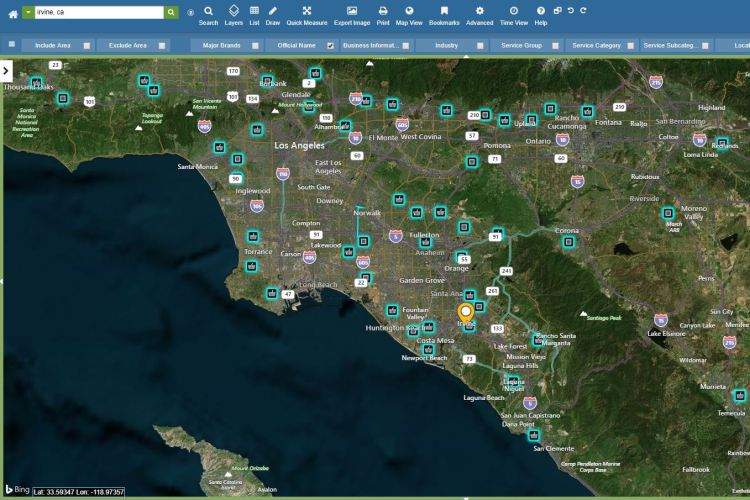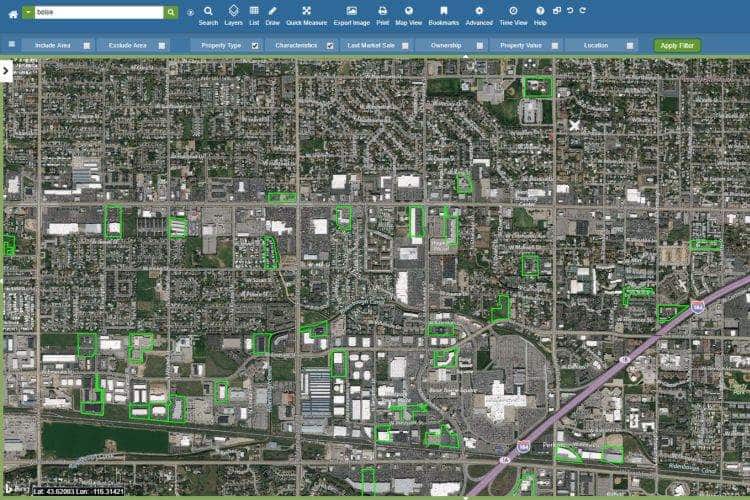As e-commerce continues to alter consumer behaviors, grocery shopping is one task consumers still prefer to do in person. Here’s how to find grocery store real estate in LandVision™.
How many deliveries have you received this week? Between meals, household items, and other goods, we are closer than ever to having all of our daily wants and needs delivered straight to our doors while we enjoy the comforts of our homes. The act of in-person shopping has always been a choice, but as e-commerce spending patterns indicate, it is increasingly becoming a second choice.

Consider the relative speed with which holiday shopping has evolved. Once the peak of yearly retail spending, Black Friday has undergone a rapid transformation with e-commerce spending overtaking in-store spending since 2017 according to Adobe. When it comes to retail, today’s consumers simply appear to prefer the convenience (and perceived savings) of digital shopping.
Despite the continued growth of e-commerce and the prevalence of delivery services for nearly every product one could need, there are still tasks that consumers prefer to do in person. An intriguing real estate trend suggests that shopping for groceries is one such task. According to Bisnow, grocery stores accounted for approximately 17 million square feet of new retail space in 2018, which represents a nearly 30% growth in this subset of the commercial real estate industry as compared to the year before. Much of this growth is concentrated in Florida, California, and Texas, but thanks to the expansion of chains like Aldi and Sprouts, this trend is being felt nationwide as well.
The site selection model for grocers is a relatively straightforward one, so let’s take a look at how a commercial real estate broker can use our map-based real estate application, LandVision™™, to help their clients find and evaluate potential sites for grocery store real estate.
Grocery Store Real Estate Requirements
As mentioned before, Sprouts is one grocery chain that is expanding its footprint across the US. As luck would have it, the company also has its site selection criteria available online. When evaluating new sites, Sprouts is looking for:
- 100,000+ population within 10 minutes
- Approximately 30,000 square foot store size
- Easy access with high traffic counts
- Minimum of 140+ parking spaces
How to Find Grocery Store Real Estate Using LandVision™™
Using the site selection guidelines from Sprouts as a framework, finding suitable properties to build new grocery stores in LandVision™™ is both fast and easy. To start, we’ll perform a point of interest search to determine where Sprouts stores are located already — just to ensure we aren’t placing a new store in the backyard of an existing one!

From our search, it looks like there are quite a few Sprouts locations near our California office! In casting a wider net, however, the city of Boise, Idaho looks like a good expansion market for the chain. Now that we know we won’t be infringing on any existing Sprouts markets, we can begin searching for properties that meet the company’s criteria. LandVision™™LandVision™<sup>™</sup> enables brokers to search for and visualize only the properties that meet all of their requirements, using parameters such as lot size, building square footage, year built, land use, assessed value, and more. We know that Sprouts is seeking buildings that are roughly 30,000 square feet, so that will be one factor that we include in our search. The company also requires at least 140 onsite parking spaces for each new location, so using a basic conversion rate of 350 square feet per parking space, we can also narrow our search to include only properties that exceed 80,000 square feet (30,000 for the building, 49,000 to account for parking, and an extra 1,000 for wiggle room). To round out our initial search, we will also limit our search to retail and commercial land use.

As you can see, our initial search returned quite a few results. Knowing that Sprouts also looks for “easy access with high traffic counts,” we can easily overlay traffic data in LandVision™™ to identify heavily trafficked areas in Boise. Major shopping centers in town are also labeled on our base map, giving us an additional indication of areas that receive more traffic than others.
Once we’ve identified promising properties, demographic overlays in LandVision™™ can help us determine if any of our target sites meet the final requirement from Sprouts: a population of at least 100,000 people within a 10-minute drive time. LandVision™™ gives us the ability to generate trade areas (choosing either distance or drive time) around any property to analyze the population within a given area. Best of all, when we are ready to present our findings to our clients, with just a single click we can generate a site profile report containing detailed property information, transaction history, ownership information, and the population characteristics of our trade area.
Learn More
Of course, LandVision™™ can be used for much more than just helping find a location for a new grocery store. Contact us today to learn how conducting detailed property research and analysis within a single application helps commercial real estate brokers save time and money, or schedule a free demo to see LandVision™™ in action for yourself! For more on this topic, check out our case study on Amazon and Whole Foods Market.